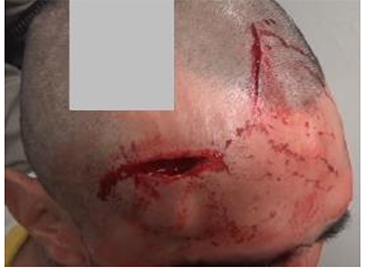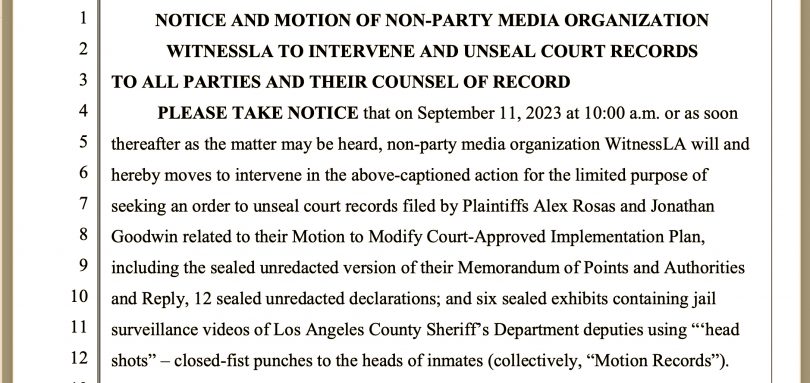On August 14, 2023, WitnessLA filed a motion to unseal six sealed exhibits containing six jail surveillance videos, several of which showed LA County Sheriff’s deputies using “‘head shots,” the term used for closed-fist punches to a detainee’s head.
Concurrent with WitnessLA’s motion, the Los Angeles Times, with help from the attorneys for the Reporters Committee for Freedom of the Press, also filed a motion for the videos to be unsealed.
WitnessLA moved to unseal the six tapes with the aid of a team of five very skilled attorneys who did the work pro bono because they believed the case was important.
The team was led by First Amendment expert Susan Seager, who worked with another colleague, plus three members of the Press Freedom Project at UC Irvine Law School, which is where the nationally known Seager teaches.
You can find the motion that the team filed on WLA’s behalf here. (If you are fond of gracefully presented legal theory, it makes for an interesting read.)
The Rosas case
To appreciate the importance of the tapes that the motion sought to unseal, it helps to know their history.
The six videos are elements of a federal class action civil rights lawsuit originally filed nearly twelve years ago on January 1, 2012, against the Los Angeles County Sheriff’s Department, then led by Sheriff Lee Baca. The lawsuit was filed by the Southern California ACLU on behalf of plaintiffs Alex Rosas and Jonathan Goodwin.
The 77-page complaint, which made up the original filing, alleged that under Baca’s leadership, LA County Sheriff’s deputies engaged in an alarming “pattern of excessive force and physical abuse” against Rosas, Goodwin, and others detained in Men’s Central Jail, Twin Towers Correctional Facility, and the Inmate Reception Center.
Baca’s notorious undersheriff, Paul Tanaka, was also named in the original complaint due to his well-documented efforts to stop reform in the jails, the dungeon-like Men’s Central Jail, in particular.
Some examples of the allegations made in the original 2012 complaint include the following:
In July 2011, two deputies beat a handcuffed inmate about the head and neck. The beating was so severe that he required hospitalization outside the jail, and has permanent hearing loss in one ear.
On March 16, 2011, three deputies beat an African American inmate until he was unconscious, then carved the letters M – Y into his scalp, the first two letters of “MYATE,” (or more commonly “MAYATE,”) a racial street slur meaning “Black.”
Also in March 2011, deputies slammed a handcuffed inmate’s head into a cement wall, leaving him with a concussion and a gash that took 35 stitches to close, then beat him around the head and face when he came to, resulting in 2 days of hospitalization and four additional days in the jail’s medical unit. (The ACLU reports that there were several witnesses to this incident.)
As WLA reported at the time, on December 16, 2014, nearly three years after the original filing, the SoCal ACLU and the ACLU National Prison Project were able to negotiate a landmark consent decree in the case. Under the agreement, LASD had to adopt a detailed plan to reform its use-of-force policies in the three jails named.
LASD’s implementation of the plan was subject to monitoring by a panel of three court-appointed experts. Enforcement of the agreement was — and still is — provided by a federal judge.
So how has the monitoring gone in the intervening years?
Well … as luck would have it, a month after WLA’s team filed their motion to unseal the six videos, that panel of three Rosas monitors submitted their most recent twice-yearly report describing how the LA County Sheriff’s Department was and wasn’t hitting the agreed upon marks to develop “a corrective action plan” designed to ensure that those residing in the jails “were not subject to excessive force and other potential forms of abuse.”
WitnessLA obtained the panel’s 51-page report, and it did not make for cheering reading.
When we discussed this newest report with Peter Eliasberg, the Southern California ACLU’s Chief Counsel, and the county’s Rosas expert, he was particularly troubled by the part of the report pertaining to head strikes and similar force issues.
The panel described, for example, how the LASD’s assistant sheriff in charge of custody, produced a video for deputies and supervisors, which highlighted “the three criteria that must be present prior to utilizing a head strike.”
So far, so good.
Yet, despite the boundaries laid out by the assistant sheriff’s video making clear the only conditions in which a head strike could be used, during this most recent reporting period, according to the oversight panel, when it came to the actual use of head strikes, the supervisors with the task of investigating and reviewing head strike incidents nearly always “concluded the force was reasonable and within departmental policy.”
However, when the panel members themselves reviewed the same incidents LASD supervisors deemed reasonable, the threesome disagreed with the department’s conclusions “in over 85% of these cases.”
The panel members were not the only experts who have recently expressed deep concern about the use of head strikes.
On May 30, 2023, a law enforcement and corrections expert named Stephen Sinclair, retained by the ACLU to further review the LASD’s use of force inside the jails, released his own 35-page report, which WLA has acquired.
The settlement agreement, Sinclair wrote, “has been in effect since September 2014. Now almost nine years later,” there appear to be “ongoing failures” that directly correlate to “unnecessary and excessive uses of force.”
Based on what he reviewed, Sinclair said, which included the panel’s latest report, plus the sealed videos, he has now concluded that the LASD must declare head strikes to be “prohibited uses of force except in life-threatening situations.”
In other words, the nation’s largest sheriff’s department needs to “elevate the use of head strikes” to the category of “deadly force,” which greatly changes how and when such techniques may be used, and what the consequences could be for using head strikes outside those boundaries.
“The fact that these failures are directly related to the health and safety of the detainees in the custody of LASD, which has a duty to protect the detainees in their custody and care, and of LASD staff,” he said, “makes it all the more critical that LASD address” the issue of head strikes “without further delays.”
To illustrate his point Sinclair included the photo below. In this instance, he wrote, deputies failed to use de-escalation but “allowed the inmate to exit the cell,” and when the inmate attempted to pull away, “one deputy grabs the inmate by the head and aggressively slams his head into a concrete wall, causing significant head trauma with lacerations to the inmate’s head.”

All this brings us back to the six sealed videos.
The unsealing
In mid-September, the two legal teams went to court to present their motions to the US District Court Judge Dean Pregerson, who is the jurist that has long been assigned to Rosas.
The hearing did not result in an immediate decision. Instead, there were approximately two months of additional delays while the LASD blurred the faces of the deputies and the jail residents pictured on the six videos, to protect the privacy of those on camera, “without compromising the informational value” of the videos, wrote the judge about the blurring.
Finally, on November 8, 2023, Judge Pregerson ruled that he would unseal the tapes.
“Having considered the submissions of the parties and heard oral argument,” the judge wrote,” the court grants the motions to intervene.”
And so it was that the videos were unsealed and released to WitnessLA and the LA Times via the ACLU. This also means that they are now available to other members of the press, and any community members who learn of their existence.
With dates ranging from October 24, 2019, to July 4, 2022, the six videos — which you can find here — depict incidents that occurred before Sheriff Robert Luna took office.
The incident pictured on the first of the videos is dated 4th of July, 2022, meaning the incident depicted occurred just six months before Luna was sworn in on December 3, 2022. Yet, while only a few seconds long, it is one of the most disturbing of the tapes.
Thanks to WLA’s and the LA Times’ teams of attorneys, and thanks to Judge Pregerson, we can judge the videos for ourselves.
The importance of unsealing the six tapes was further illustrated in a recent op-ed by our friends Miriam Krinsky, founder and executive director of Fair and Just Prosecution and Alex Busansky, the president and founder of Impact Justice.
In the op-ed, the twosome wrote about the effect of the videos on their perspectives, even though both Krinsky and Busansky are very familiar with conditions in the LA County jail system and other problem-plagued custody systems, because, among other things, they were both part of the Los Angeles County Citizens’ Commission on Jail Violence (CCJV), which as readers may remember was charged with investigating — and crafting recommendations to address — the decades-long pattern by sheriff’s deputies of using excessive force in LA County’s jails.
Yet, despite their range of experience, and despite the detailed testimony Krinsky and Busansky heard for weeks from department members, former jail detainees, and others during the 2012 CCJV hearings, the twosome wrote that seeing the six unsealed videos shook them in a manner they didn’t expect.
“It’s one thing to hear about excessive force incidents inflicted upon LA County jail residents at the hands of Sheriff’s Department personnel,” they wrote.
“It’s another thing to see them. Either way it’s troubling, but recently released videos of blatant assaults on individuals in the county’s care struck a more urgent chord.”
Yes. We thought so too. Hence our commitment to unsealing them.
****
Postscript:
WitnessLA remains deeply grateful to Susan Seager and her remarkable team of UC Irvine law students: Elizabeth Monroe, Iviana Villanueva, and Claudia Diaz Martinez. And Jack Lerner, also of the University of California Irvine School of Law.
You are the best of the best.
There’s a lot more to this story so….stay tuned.


Great article!
Without any rhetoric, transparency within tho Los Angeles County Jail system would bring about exposure.
Time tells all, usually sooner than later as we see every week, revealing LASD’S antics and tactics.